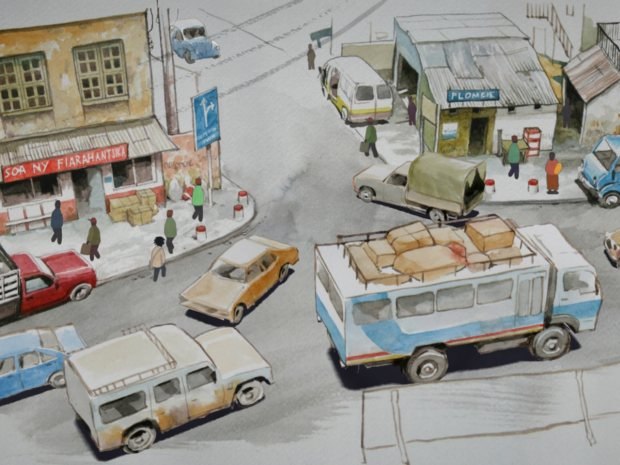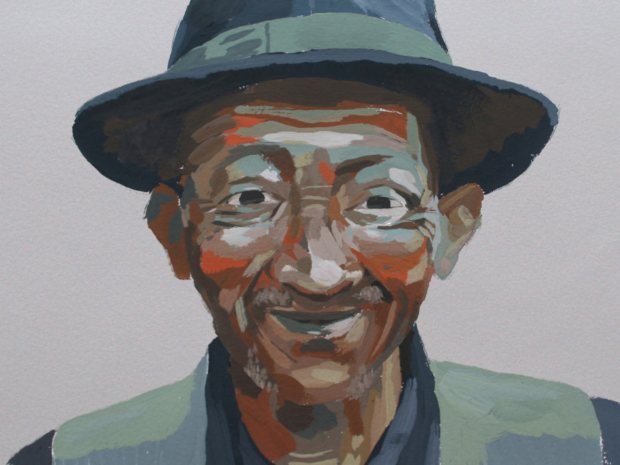Bastien Dubois tells us about his personal journey making Madagascar, Carnet de Voyage.
Check out more about Madagascar in the 2011 AWN Oscar Showcase at AWNtv!
Madagascar, Carnet de Voyage is a sketch-book-style journey as a European traveler confronts being a stranger in a strange land in Madagascar. As pages of his diary turn, colorful pencil sketches come to life, revealing the beautiful landscapes as well as the Famadihana customs.
Bill Desowitz: What was the experience like and how did it evolve into your film?
Bastien Dubois: When I was 21, I traveled from Lille, in the north of France to Istanbul by hitchhiking across Italy and Greece. During this trip, each day I was sketching with water colors, pencils and paint. I wanted to do a book about my trip. When I came back to France, I started to study at Supinfocom, the 3D animation school where I learnt the techniques I used to do my short.
I made a 3D test and a drawing while I was in Italy to do my first camera map. The result was impressive and gave me the idea to do my travel diary not printed, but animated! Then I met someone from Madagascar who told me about the Famadihana [the turning of the bones dance ceremony]. When I heard about it, I knew that telling that story was my subject. Then I moved to Mada for 10 months and went to a Famadihana for the first time. When I was in Madagascar, I was all the time aware of elements, details, sounds… I was going to add to the film.
BD: Did you make this by yourself or did you have help?
BD: Most of the time I worked alone but during a couple months, four trainees helped me and an animator at the end of the production when I was exhausted. I spend a year-and-a-half looking for money and two years making this 12-minute short.
BD: What was the sketch-book process like? It seems so simple yet rich with possibilities.
BD:
The idea came naturally in making an animated diary. The main challenge was to avoid the digital aspect. In a way, I was looking for spectacular camera movements and, at the same time, looking for a result in which you can't detect the use of computer. I did maybe 30cm high of drawings…
BD: What about all the different techniques? Watercolor, line-drawing, oil painting, charcoal?
BD: Every time I started a new shoot, I didn't know which technique I was going to use. I changed all the time depending on what I wanted to show in the shoot. There was no strategy about using a particular technique for a shot or another. I made the shots randomly, but sometimes I was using particular techniques. For example, only water techniques for the rice fields or dry techniques for the dusty part of the dance. I also used the embroidery and a stop-motion shot with little cars made of steel cans by the Madagascar children, which are two shots I like particularly.
For me, the nature of a journey diary is to be a patchwork of different techniques and time spent on a drawing (not in terms of quality but achievements ) glued stuff…Sometime I rotoscoped, sometimes I rotoscoped 3D, sometime texture 3D characters with animated texture, sometime I printed each frame and painted everything...
BD: What were the most difficult parts?
BD:
When the diary opens and closes at the beginning and the end of the film. I spent a lot of time on these scenes. These shots are very complex and dealing with a lot of different footage and elements. They are the two most important shots of the film because they open and close the film… it is these shots that people will remember the most I guess. It was also very difficult to have coherence with all these different techniques, and to know when I had to stop improving the film. And also to work alone during such a long time... and Malagasy administration! There were a lot of difficulties…
BD: What was it like screening the film in Madagascar?
BD:
I spent four or five years working on this film and my favorite memory is returning to Madagascar in December 2009 to screen the movie. The town where the film takes place is very remote, so I rented a bus to carry everyone to a theater in the closest city. Everyone was seated in the theater but the projector broke down.It was a very long 45 minutes. Thankfully, the Kintana Manga musicians didn't understand that we were going to see the movie, and brought their instruments (they thought we were going to record again!), so they started playing "Hira Gasy" (typical Malagasian music) in the theater. It was amazing! Finally, the projector was fixed, so everyone was able to watch the movie. Everybody was extremely moved. It was the first time they ever went to a theater...
Bill Desowitz is senior editor of AWN & VFXWorld.










